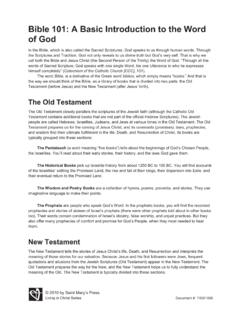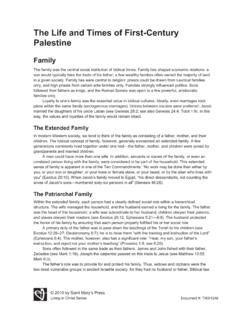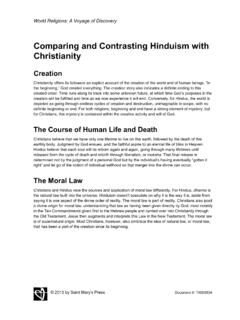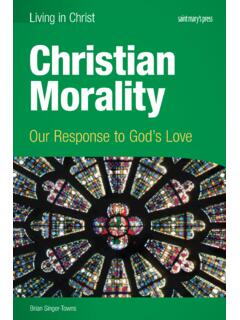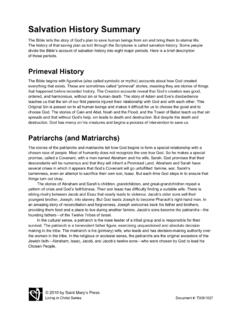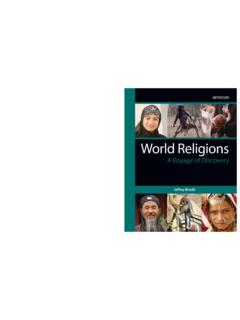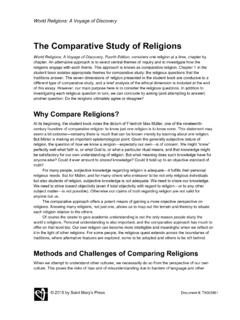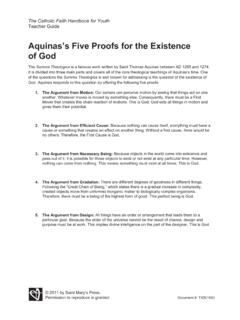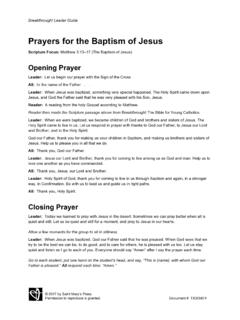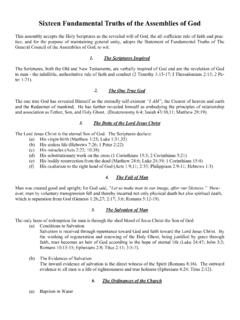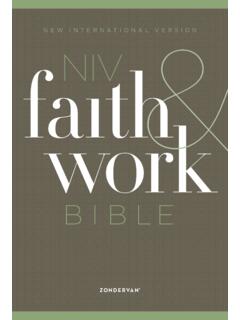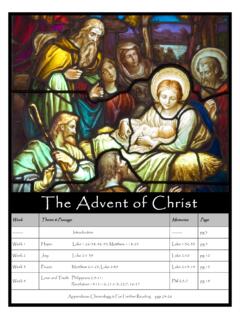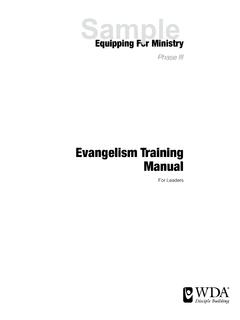Transcription of TX001327 1-Background-Political and Religious Structure in ...
1 2010 by Saint Mary s PressLiving in Christ SeriesDocument #: TX001327 The Political and Religious Structure in Jesus TimeIn looking at the political and Religious Structure at the time of Jesus, we could explore countless topics. In this article we look at topics of the Structure of the Jewish sects, the practice of taxation and tithing, and the exercising of crucifixion as a means of execution and SectsJust as Christianity today is divided into different groups (Catholics, Methodists, Lutherans, nondenominational evangelical churches), so too ancient Jewish religion had distinct groups or sects. InJesus time in Palestine, three groups were particularly influential. Josephus identifies these groups (he calls them philosophies ): the Sadducees, the Pharisees, and the should make clear from the start that only a small minority of people actually belonged to these sects, but their strong influence on Jewish society is undeniable.
2 The Pharisees were the largest of the three, consisting of about six thousand members during the time of Herod the Great (out of a total population of perhaps one million people in Palestine). These groups can be compared not only to christian denominations but also to modern political parties. In ancient Judaism there was no sharp distinction between religion and politics. All three groups were concerned not only with Religious behavior but also with the political issues of their name Sadducees most likely comes from the name Zadok, a priest who anointed David s son Solomon as king (see 1 Kings 1:32 40). The descendants of Zadok, the Zadokites, were recognized as the only legitimate priests by Ezekiel (see Ezekiel 44:9 31) and the author of the Book of Chronicles. It s likely that the Sadducees were Zadokites who supported the Hasmonean (descendants of the Maccabees) kings and priests.
3 The Sadducees were apparently of the elite, wealthy class, and were closely allied with the high priestly families. Josephus says the Sadducees had a following among the rich only, while the Pharisees had a greater following among the common people. In the Acts of the Apostles, the Sadducees are associated with the high priest and the Jerusalem Temple (see 4:1 2, 5:17). Josephus names the high priest Ananus as a New Testament times, the high priest was appointed by King Herod, the client king of the Romans, then by Herod s son Archelaeus, and later directly by Roman rulers of Judea. With their connections with the high priestly families, the Sadducees were closely tied to Roman rule in Jews held a variety of different beliefs about the afterlife. Josephus says the Sadducees believed that the soul died along with the body; the Acts of the Apostles reports that the Sadducees say that there is no resurrection or angels or spirits, while the Pharisees acknowledge all three (23:8).
4 Members of the Sadducees tried to show that the belief in resurrection was not logical when they asked Jesus about a hypothetical case in which a woman had married seven men. In the life afterresurrection, whose wife would she be? (see Mark 12:18 27). Jesus answered them, When they rise from the dead, they neither marry nor are given in marriage, but they are like the angels in heaven (12:25). In other words, the normal standards of marriage do not apply in the resurrected to Josephus, the Pharisees and Sadducees were often in conflict. The Pharisees taught many Religious rules that were not directly in the Torah; the Sadducees rejected all laws that were not The Political and Religious Structure in Jesus TimePage | 2 2010 by Saint Mary s PressLiving in Christ SeriesDocument #: TX001327 explicitly written in the Torah. Josephus also reports that the Sadducees were harsher in their legal judgments and punishments than were the Pharisees.
5 The rabbinic literature often portrays the Pharisees and Sadducees disagreeing about matters of appears that most members of the Pharisees were not priests. They had considerable influence in Israelite society Josephus reports that at the beginning of the revolt against Rome in AD 66, the leading Pharisees met with the high priests and men of power in an attempt to resolve the political influence, however, was indirect. The Pharisees did not hold political offices but rather influenced such leaders as the Hasmonean Queen Salome Alexandra and later Herod the Great. Mark portrays the Pharisees as plotting with the Herodians to destroy Jesus (see Mark 3:6, 12:13). They did,however, serve on the council ( Sanhedrin ) that advised the high priest (see Acts of the Apostles 5:34,23:6 9).Origins of the PhariseesMany scholars think the Pharisaic party evolved from a group known as the Hasideans, zealous supporters of the Torah who joined the Maccabean revolt: Then they were joined by a group of Hasideans, valiant Israelites, all of them devout followers of the law (1 Maccabees 2:42).
6 The name Hasideans comes from the Hebrew hasid, meaning pious or devout. Most scholars also believe the Pharisaic movement later developed into rabbinic Judaism. This Judaism, based on the Scriptures as interpreted by the Mishnah and Talmud, is the form of the Jewish faith that has survived into modern times. Thus careful study of early rabbinic documents, such as theMishnah (ca. AD 200), allows us to gain some insights into the Pharisees teaching at the time of Pharisees are often portrayed in the Gospels as hypocritical, concerned more with outward show than with sincere faith, for they preach but they do not practice (Matthew 23:3; see also 23:4 5,25 28). Jesus contrasts the prayers of a self-righteous Pharisee with a humble tax collector; it is the tax collector who goes away justified by God (see Luke 18:9 14). It is not surprising that the Gospel writers tended to focus on negative aspects of the Pharisaic movement, as early Christians and Pharisees were in serious conflict over basic issues, such as the observance of s portrait is much more positive.
7 He reports that the Pharisees avoided luxury and lived a simple lifestyle. In contrast to the Sadducees, they enjoyed support among the and the TorahThe primary aim of the Pharisees was to apply the details of the Torah to everyday life. Many of the commandments of Torah are vague, and at times they are inconsistent or even contradictory. The Pharisees worked out practical methods to overcome these were well known for traditions that they taught as a supplement to, or as an interpretation of, the commandments of the Torah. The synoptic Gospels report that the Pharisees were meticulous about washing their hands and purifying themselves before eating (see Mark 7:3 4); they apparently appliedsome priestly purity laws to their own daily meals. Another tradition was the declaration of something as qorban a dedication of a possession to the Temple that allowed a person to continue using it for himself and not sharing it with others (see 7:11).
8 The Political and Religious Structure in Jesus TimePage | 3 2010 by Saint Mary s PressLiving in Christ SeriesDocument #: TX001327 Josephus reports that the Pharisees were lenient in their judgments about punishments, and we know that some of their traditions allowed Jews to observe the Torah in an easier and more practical manner. For example, strict biblical laws forbade carrying food from house to house on the Sabbath. ThePharasaic tradition of eruv allowed the construction of doorposts and lintels so that several houses could be joined together as one, and families could thus socialize on the Sabbath. The tradition of the prosbul allowed a debt to be collected by a community council, even during the seventh year, when, according to biblical law (see Deuteronomy 15:2), all debts were to be forgiven. This practice made it easier for farmers or craftsmen to get loans when the seventh year was and Early ChristiansAlthough the Gospels often portray Jesus in conflict with the Pharisees (see Mark 2:23 28, 3:1 6), the relationship between the Pharisees and the early christian movement was more complex.
9 Followers of Jesus and the Pharisees (in contrast to the Sadducees) shared a belief in the resurrection of the dead and punishment and rewards in the afterlife. The Apostle Paul was a Pharisee (see philippians 3:5, Actsof the Apostles 23:6). Pharisees were also part of the first church community at Jerusalem (see Acts of the Apostles 15:5). Besides Paul, other notable first-century Pharisees were Gamaliel, an influentialmember of the Sanhedrin who was respected by all the people (5:34), and the priest, general, and historian scholars identify at least one branch of the Essenes with the community that lived in the desert wilderness at Qumran (although other scholars reject this connection). Qumran is the site on the northwestern end of the Dead Sea at which the so-called Dead Sea Scrolls were found. The Qumran community was governed by a strict hierarchy headed by priests; the so-called Teacher of Righteousness (often mentioned in the scrolls) was apparently the founder of the community seems to have begun when a group of priests left Jerusalem because of a dispute with the Temple priesthood.
10 They disagreed with the interpretation of Torah practiced by the Jerusalem priests, and especially with interpretation of laws of purity. It is likely that the Qumran communitymembers, with their belief that only a Zadokite should be high priest, rejected the non-Zadokite Hasmonean high priests. The community further disagreed with the Hasmonean adoption of a solar calendar in place of the old lunar one. This dispute was important, as knowing the precise date wasessential for keeping the festivals mandated in the Dead Sea Scrolls include many copies of biblical books, commentaries on Scripture, hymns, prayers, and rules for governing the community. One scroll, the War Scroll, describes a final battle at the end of history in which the Sons of Light (the Qumran community), aided by God, will destroy the powers of darkness (the forces of the community s Jewish opponents as well as Gentiles).
